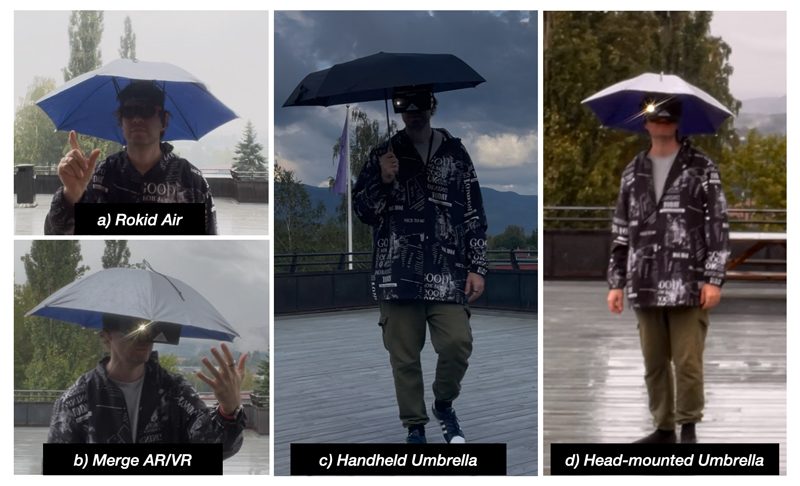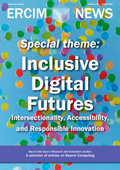by Attila Bekkvik Szentirmai (University of South-Eastern Norway)
A rainy-day pilot shows how current AR headsets struggle outdoors, turning ordinary weather into amplified situational disabilities and underscoring the need for weather-ready inclusive design.
Augmented Reality as a Daily Companion
Augmented reality (AR) promises everyday assistance by simultaneously overlaying digital information onto the user's physical world [1]. Application areas already include entertainment, education, and healthcare in controlled environments. However, the long-term vision is for AR to serve as a daily companion, functioning seamlessly both indoors and outdoors.
For this vision to succeed, AR must cope with ordinary environmental conditions such as bright sun, low light, rain, or cold, often while the user is on the move. These situations can create situational disabilities [2], temporary impairments caused not by the user’s abilities but by the context of use. Sunlight can reduce visibility, cold hands can limit motor control, and noise can weaken auditory perception. Designing with such conditions in mind is critical, since it improves usability and accessibility for everyone, whether their challenges are situational or permanent.
Two Head-Mounted AR Paths, Two Weaknesses
Head-mounted AR devices generally follow two approaches, each with weaknesses. Optical see-through (OST-AR) preserves natural sight by projecting overlays onto transparent lenses [3], but overlays often wash out in sunlight, and darkened lenses used to improve contrast reduce real-world visibility, similar to wearing sunglasses indoors. Video pass-through (PT-AR) captures the environment with cameras and shows it on a screen with overlays [3], but sensor limits can introduce artifacts such as reduced dynamic range, tunnel vision from narrow fields of view, or blurred details from fixed focus, resembling myopia or hyperopia.
A Rainy-Day Pilot
To explore these challenges, we conducted a small exploratory pilot in rainy conditions. One researcher tested two representative devices: an OST-AR headset (RokidAR; see Fig. 1a) and a PT-AR smartphone-based system (MergeVRAR; see Figs. 1b–1d). This was not a formal user study but an experiential trial of outdoor use.

Figure 1: Outdoor pilot with AR. (a) Rokid Air [L1] used in rain with a head-mounted umbrella. (b) Merge AR/VR [L2] used in rain with a head-mounted umbrella. (c) Testing with a traditional handheld umbrella. (d) Testing with a head-mounted umbrella in the rain.
The observations were clear. Bright backgrounds made OST-AR overlays nearly invisible, resembling temporary low vision. PT-AR was even more fragile: a single raindrop on the camera could obscure the view and effectively blind the wearer. Attempts to wipe it away often made matters worse, as instinctive movements toward the eyes collided with the headset, and the misalignment between “camera eyes” and natural vision added to the disorientation. In both cases, even light rain quickly made the devices difficult to use, leading to impaired mobility. Simple tasks such as navigating from point A to point B or interacting with physical objects had to be abandoned, because even standing still proved challenging without constantly checking one’s arms and feet for reference and balance.
Mitigation Attempts
We tried simple protective strategies, but each created new problems. A handheld umbrella kept the devices dry but occupied one hand (see Figure 1c) and at times blocked the forward-facing cameras. A head-mounted umbrella freed the hands (see Figures 1.a, 1b, and 1d) but added weight, increased wind drags, and occasionally covered sensors. It also attracted attention in ways that many users would find uncomfortable. These trials revealed a common pattern: fixes for one barrier often introduced new burdens. Even seemingly minor details, like how to keep optics dry, had major consequences for accessibility when AR was expected to serve as a daily companion.
Design Lessons
The pilot highlights the need for new priorities in AR design. Headsets must be weather-ready, with clear protection standards and operational limits for rain, fog, and glare. OST-AR optics should preserve legibility of overlays without reducing natural visibility, and PT-AR systems need lower latency to maintain coordination and comfort. Finally, evaluation protocols should treat glare, precipitation, motion, and occupied hands as first-class test conditions rather than rare edge cases.
Conclusion
This article does not dismiss AR’s potential for accessibility. After nearly a decade of work on inclusive AR, we have seen benefits from context awareness, embedded intelligence, and multimodal feedback in controlled settings, as demonstrated in earlier work [1]. Yet as this rain-field pilot shows, current devices amplify situational disabilities outdoors. Making AR truly inclusive will require weather-ready hardware, careful attention to environmental factors, and designs that anticipate outdoor use.
Links:
[L1] https://smartcarting.com/rokid-air-ar-glasses-review-and-features/
[L2] https://mergeedu.com/headset
References:
[1] A. B. Szentirmai, “Universally designed augmented reality as interface for artificial intelligence-assisted decision-making in everyday life scenarios,” Stud. Health Technol. Inform., vol. 320, pp. 469–476, 2024. https://doi.org/10.3233/SHTI241043
[2] A. Sears and J. A. Jacko, “Understanding disability and accessibility,” in The Human-Computer Interaction Handbook, 2nd ed. Boca Raton, FL: CRC Press, 2009, pp. 827–852.
[3] A. B. Szentirmai, O. A. Alsos, A. B. Torkildsby, and Y. Inal, “Are you drunk? No, I am CybAR sick! Interacting with the real world via pass-through augmented reality is a sobering discovery,” Front. Virtual Real., vol. 6, 1533236, 2025. https://doi.org/10.3389/frvir.2025.1533236
Please contact:
Attila Bekkvik Szentirmai
University of South-Eastern Norway, Department of Business and IT










